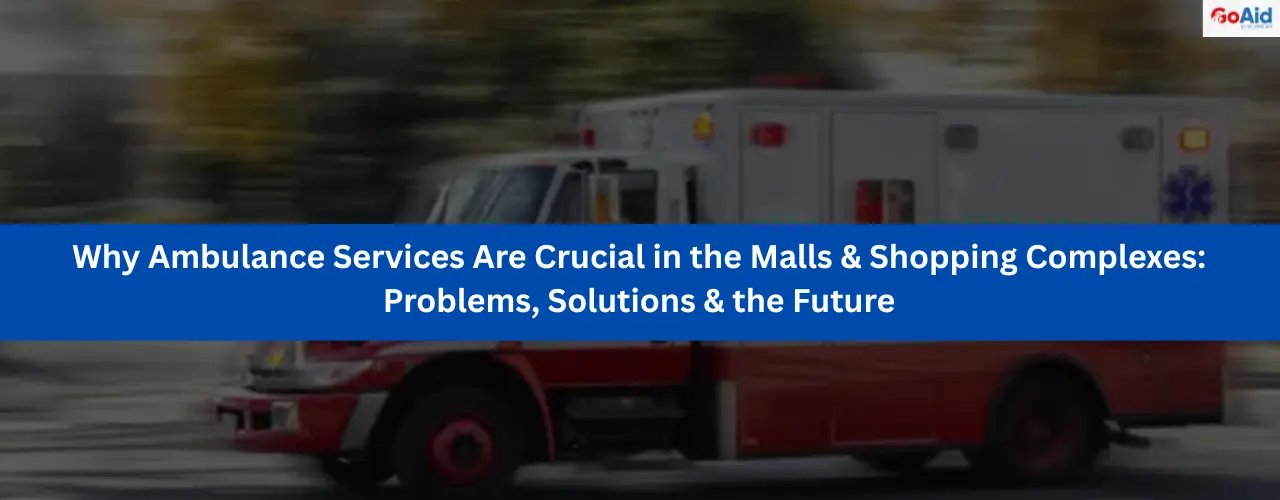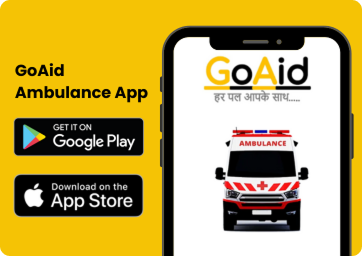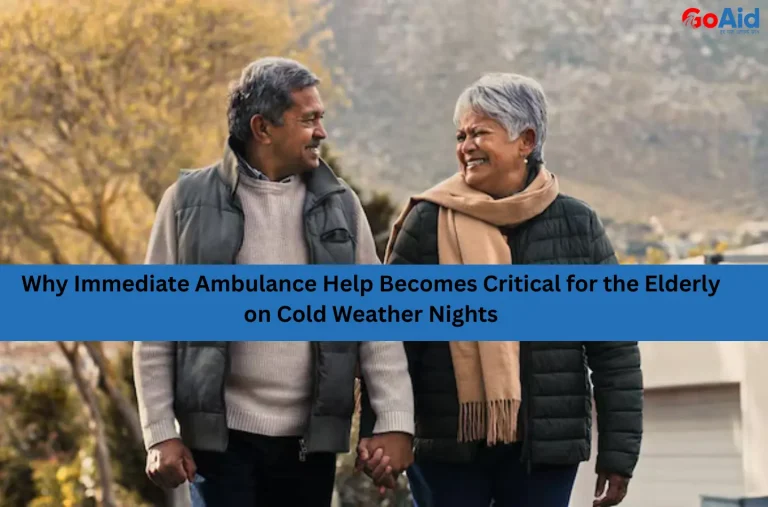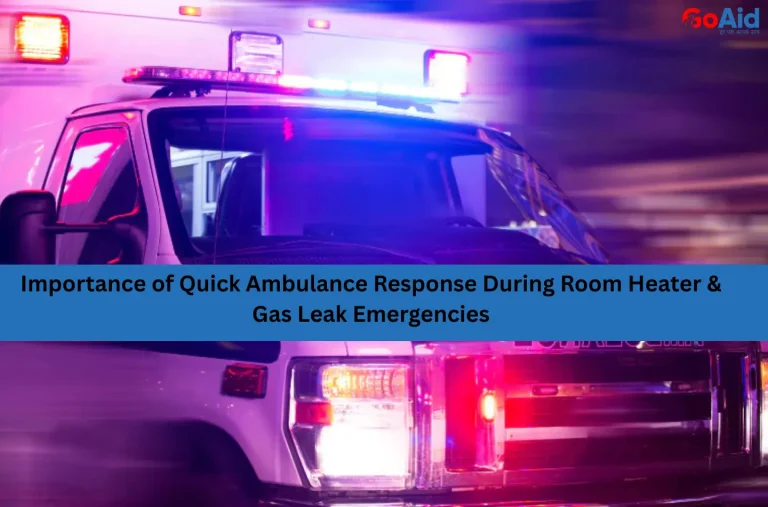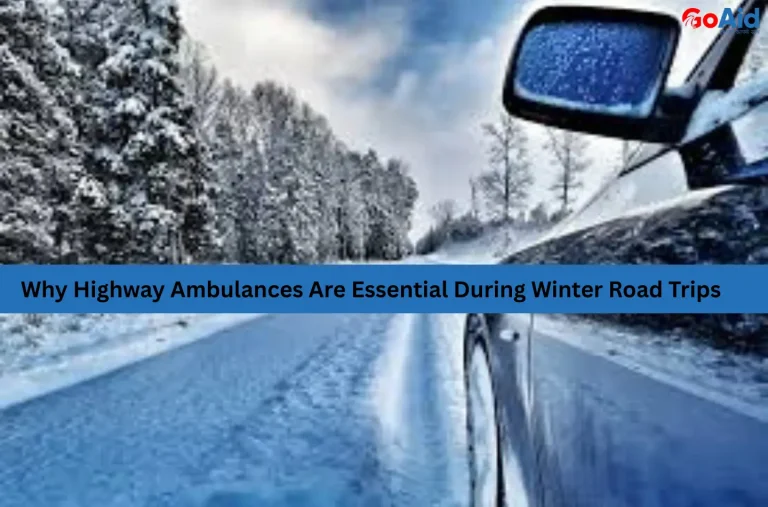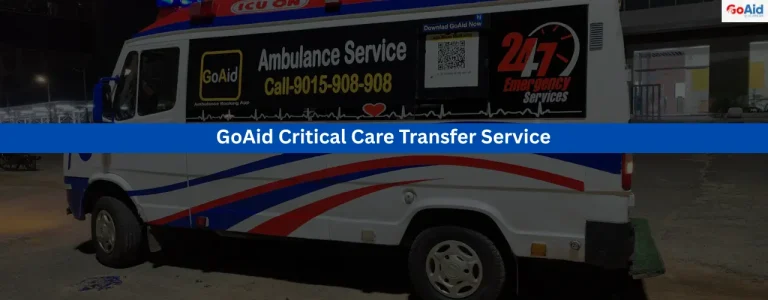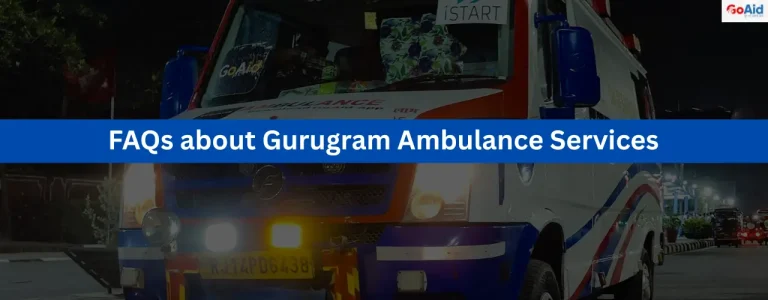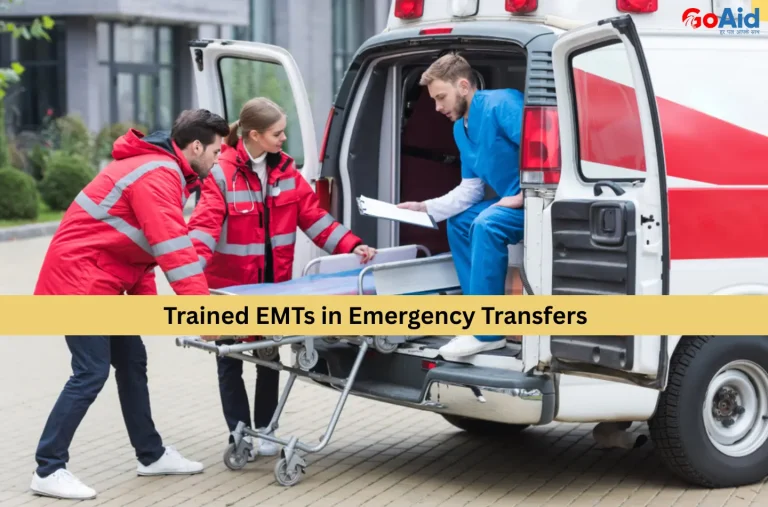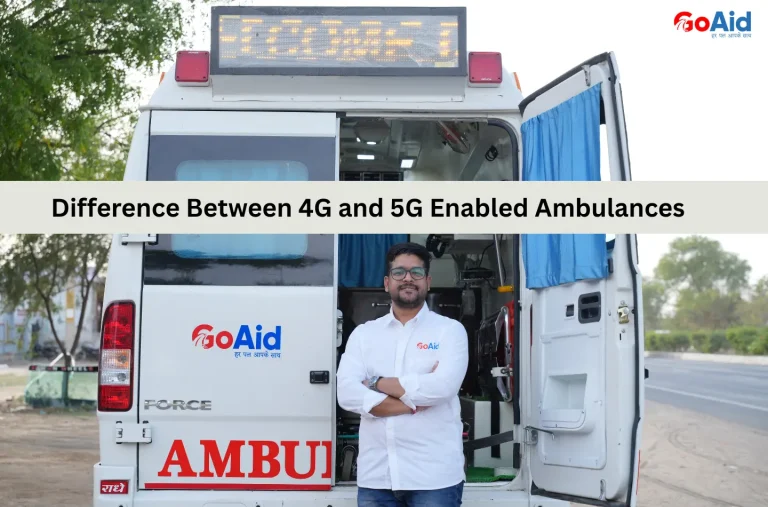In India, Malls & Shopping Complexes attract thousands of people every day. From minor injury to cardiac arrest, a medical emergency can happen anywhere at any time. ThatŌĆÖs why, for ensuring public safety, fast and reliable ambulance service for Malls & Shopping Complexes is very crucial.
After reading this blog, you will get to know about the need for ambulance services in malls & shopping complexes, current challenges in providing ambulance services to malls & shopping complexes, and how GoAid can be used as a Reliable Partner for Construction Ambulance Needs. Are you interested in reading about it? If your answer is yes, then you donŌĆÖt need to wait any longer
LetŌĆÖs start reading
Common Health & Safety Problems at Malls & Shopping Complexes
The modern malls are complex ecosystems, and they pose various health and safety risks. Below are some of the most common emergencies that demand a reliable ambulance at Malls & Shopping Complexes.
- Slips, Trips, and Falls: Wet floors, escalator accidents, or crowded walkways often lead to serious injuries like fractures or head trauma. An ambulance at Malls & Shopping Complexes ensures rapid medical support to avoid escalation and long-term complications.
- Cardiac Arrests and Medical Episodes: Sudden heart attacks, seizures, or asthma attacks are common in crowded public spaces. A dedicated ambulance for Malls & Shopping Complexes provides life-saving emergency care and ensures timely hospital transfer when every second counts.
- Elevator and Escalator Malfunctions: Unexpected elevator drops or escalator jams can result in crush injuries or trauma. A mall & Shopping complex’s ambulance service on standby ensures victims receive prompt stabilization and safe transportation to emergency facilities.
- Food Poisoning and Allergic Reactions: Food court contamination or unknown allergens can cause severe reactions in minutes. An ambulance for public safety at the mall is vital to administer first aid, manage shock, and ensure immediate care.
- Fire and Smoke Inhalation Emergencies: Short circuits, kitchen fires, or electrical faults can spread rapidly, leading to burns or smoke inhalation. Malls & Shopping Complexes, emergency care via equipped ambulances can treat victims on-site and ensure safe evacuation.
- Fainting and Dehydration Due to Overcrowding: Peak hours and poor ventilation can cause fainting, especially in children and the elderly. A quick-response ambulance for Malls & Shopping Complexes helps in providing fluids, oxygen, and transportation to nearby medical centers.
- Violence or Crowd Panic Injuries: Malls may witness fights, panic-induced stampedes, or robbery attempts. Injuries from such incidents demand rapid trauma care. An ambulance at Malls & Shopping Complexes ensures quick medical attention and supports security teams during such crises.
Why Ambulance Services Are Essential for the Malls & Shopping Complexes
An Ambulance Service for Malls & Shopping Complexes has become essential. These services ensure faster responses, enhanced public safety, and immediate emergency care for a wide range of incidents.
- Ensures Immediate Medical Attention: A stationed Malls & Shopping Complexes ambulance service offers immediate medical help during emergencies like heart attacks or falls. This reduces the risk of fatalities and helps stabilize the patient before hospital transfer.
- Reduces Response Time in Critical Situations: Time is vital in emergencies. An on-site ambulance at Malls & Shopping Complexes ensures that help reaches within minutes, especially in life-threatening cases like cardiac arrest, stroke, or major trauma.
- Boosts Public Confidence and Safety: Knowing that Malls & Shopping Complexes emergency care is readily available increases customer confidence. It enhances the mallŌĆÖs reputation as a safe and responsible public space for families and individuals.
- Supports Security Emergency Protocols: Ambulance presence complements mall security during stampedes, bomb scares, or violent incidents. It allows the ambulance for public safety to intervene quickly and transport injured individuals without delay.
- Assists in Fire and Electrical Emergencies: Fires or short circuits can happen in food courts or shops. A dedicated Malls & Shopping Complexes ambulance service ensures immediate oxygen support and burn care, saving precious time in emergencies.
- Vital for Handling Children and Senior Citizens: Children and elderly visitors are more prone to medical issues. Quick access to an ambulance for Malls & Shopping Complexes ensures timely care in cases of fainting, falls, or chronic disease flare-ups.
- Manages Unpredictable Situations like Food Allergies: Food courts may trigger allergic reactions or poisoning. Having first aid in Malls & Shopping Complexes, along with a standby ambulanc,e ensures swift care and transportation to a nearby hospital.
Types of Ambulance Services Might be Required in the Malls & Shopping Complexes
Different emergencies demand different medical support. ThatŌĆÖs why a variety of ambulance for Malls & Shopping Complexes is required, tailored to specific needs like trauma, burns, cardiac issues, or even patient transport.
- Basic Life Support (BLS) Ambulance: Ideal for minor injuries or fainting episodes. A BLS ambulance at Malls & Shopping Complexes is equipped with essential medical tools and trained staff to handle basic emergencies until further treatment is provided.
- Advanced Life Support (ALS) Ambulance: Used for serious medical emergencies like cardiac arrest or seizures. Malls & Shopping Complexes, emergency care with ALS ambulances can administer advanced medical support such as IV therapy, defibrillation, and oxygen.
- ICU Ventilator Ambulance: In rare but severe emergencies, ICU ambulances offer intensive care during transport. This Malls & Shopping Complexes ambulance service is equipped for patients needing critical life support while being moved to a hospital.
- Dead Body Mortuary Van: In case of unfortunate deaths on the premises, a Malls & Shopping Complexes injury ambulance, like a mortuary van, helps with dignified and professional removal of the deceased, following all legal protocols.
- Ambulance with Freezer Box: For cases where immediate cremation is not possible, ambulance for public safety with freezer boxes preserves the body while waiting for family or official procedures, maintaining hygiene and legal compliance.
- Event-Based Standby Ambulance: During special events, promotional sales, or festive rush, malls must deploy a standby ambulance at Malls & Shopping Complexes to handle mass footfall and unexpected emergencies quickly.
- Transport Ambulance for Non-Emergency Cases: Sometimes, a visitor may need simple transfer to a hospital without any immediate threat. A transport ambulance for Malls & Shopping Complexes ensures safe movement in such non-critical cases.
Read More: Difference between BLS Ambulance and ALS Ambulance
Current Challenges in Providing Ambulance Services to Malls & Shopping Complexes
In India, many Malls & Shopping Complexes ambulance services face operational and logistical barriers. Below are the current issues hampering effective medical emergency preparedness in commercial complexes.
Limited On-Site Space for Ambulance Parking: Many malls lack dedicated parking or access points for ambulances, delaying arrival. Without a proper ambulance at Malls & Shopping Complexes, response time can be critically affected during peak hours.
Untrained Mall Staff for Emergency Coordination: Security guards or staff often lack basic medical training. Without coordination with an ambulance for public safety, patients might face delays in reaching care or receiving initial assistance on-site.
Heavy Visitor Footfall Blocks Ambulance Movement: During weekends or events, crowded premises make it hard for Malls & Shopping Complexes ambulance service to navigate inside or outside the complex, wasting precious emergency response time.
Lack of Awareness About First Aid Locations: Visitors and staff often donŌĆÖt know where to find first aid in Malls & Shopping Complexes. This lack of awareness delays immediate care and increases the chances of complications.
Delayed Emergency Response Due to Bureaucracy: Approval from mall management or security sometimes delays ambulance access. An efficient Malls & Shopping Complexes emergency care system must bypass red tape for faster intervention.
Absence of Government-Mandated Health Protocols: There are no strict laws mandating ambulance for Malls & Shopping Complexes, making it optional for mall owners. This results in inconsistent emergency preparedness across different cities.
High Cost of Maintaining Ambulance Readiness: Mall owners may hesitate to invest in dedicated ambulances due to operational costs. Despite its necessity, Malls & Shopping Complexes injury ambulance readiness is often neglected for financial reasons.
How Can These Problems Be Solved?
In India, Solving Malls & Shopping Complexes emergency care challenges requires proactive planning, modern technology, and strategic partnerships. The following solutions ensure safer shopping environments and faster response to any medical emergency in Malls & Shopping Complexes.
- Designated Ambulance Parking Zones: Every mall should designate a clear, easily accessible area for the ambulance at Malls & Shopping Complexes to park and operate, ensuring quick movement and zero delay during emergencies, especially during high-traffic hours.
- Mandatory On-Site Ambulance Service: Having a permanent ambulance for Malls & Shopping Complexes during operational hours guarantees quick medical help. This could include BLS or ALS ambulances ready to handle all levels of emergencies at any time.
- Emergency Coordination Training for Mall Staff: Security guards and key staff must be trained in basic first aid in Malls & Shopping Complexes and emergency coordination. This ensures a faster initial response before the medical team arrives.
- Tie-ups with Professional Ambulance Providers: Partnering with reliable services like GoAid ensures expert Malls & Shopping Complexes ambulance service. These professional providers come with trained paramedics, the latest medical equipment, and fast response models tailored to public spaces.┬Ā
- Emergency Signage and First Aid Zones: Clear signage and easily accessible first aid in Malls & Shopping Complexes can guide staff and visitors during emergencies. This boosts efficiency until the ambulance team reaches the scene.
- Government Incentives and Regulations: The government must offer tax relief or grants for malls that install ambulances for public safety systems. Mandatory emergency setups should be part of commercial licenses and compliance audits.
- App-Based Emergency Activation Systems: Malls should integrate panic buttons or app-based systems linked to a Malls & Shopping Complexes emergency care provider. These digital tools can cut down manual delays and speed up ambulance arrival times.
Future of Emergency Medical Services in the Malls & Shopping Complexes
The future of ambulance for Malls & Shopping Complexes lies in smart tech, policy enforcement, and customized healthcare solutions. Here are 10 innovations and trends that will redefine Malls & Shopping Complexes emergency care.
- AI-Powered Emergency Alert Systems: Using AI to detect crowd patterns, health incidents, or falls can auto-alert a mall or shopping complex’s ambulance service without needing manual calls.
- Smart Ambulance Integration with Mall Security: Future ambulances for public safety will sync in real-time with mall surveillance, allowing quicker identification of incidents and route clearing.
- Mall-Based Health Kiosks: Mini health booths offering vitals checks and teleconsultation will act as first-response zones before the ambulance at Malls & Shopping Complexes arrives.
- Drone Surveillance for Emergency Monitoring: Drones can help security teams identify medical emergencies in Malls & Shopping Complexes more efficiently, improving ambulance coordination.
- Digital Emergency Maps for Staff: Mobile maps guiding staff and visitors to first aid in Malls & Shopping Complexes and ambulance points will be the norm.
- Automated Traffic Clearance for Ambulances: Future infrastructure may support smart traffic lights that clear paths for incoming Malls & Shopping Complexes ambulance service vehicles.
- Telemedicine Support Inside Ambulances: Modern ambulances will have telemedicine features to consult specialists en route, enhancing Malls & Shopping Complexes’ emergency care during critical situations.
- Data-Driven Risk Management: Analytics will predict common incident zones and times, helping to place ambulances for Malls & Shopping Complexes more effectively.
- Legal Mandate for 24/7 Ambulance Presence: The government may legally require malls to have a stationed ambulance at Malls & Shopping Complexes, like fire exits.
- Community Health Awareness Campaigns: Public education inside malls about first aid and safety will improve emergency preparedness and reduce avoidable escalations.
Legal Obligation of Ambulances for the Malls & Shopping Complexes in India
With increasing footfall, ensuring public safety in malls is not optionalŌĆöitŌĆÖs a social and legal responsibility. HereŌĆÖs how ambulance for Malls & Shopping Complexes should be integrated under IndiaŌĆÖs evolving regulatory and moral framework.
Mandatory Health Infrastructure in Large Spaces:
The commercial spaces over a specific area must include emergency services. Malls & Shopping Complexes’ ambulance service should be a part of compliance with local municipal and fire safety regulations.
- Public Safety as a CSR Obligation: Malls can include an ambulance for public safety in their CSR initiatives. Providing free ambulance services in case of emergencies reflects a responsible brand image and fulfills community expectations.
- Legal Penalty for Emergency Negligence: Failing to provide Malls & Shopping Complexes emergency care during a crisis can attract legal action under public safety laws, especially if injury or death occurs due to negligence.
- Safety Certification for Commercial Licenses: Only those malls that fulfill safety protocols like first aid in Malls & Shopping Complexes and 24/7 ambulance support should be allowed to operate commercially.
- Right to Life under the Indian Constitution: The absence of an ambulance at Malls & Shopping Complexes violates the constitutional right to life during emergencies. This can be challenged in court by affected individuals or families.
- Collaboration with Government Health Departments: Malls must coordinate with state health departments to meet national emergency response guidelines, ensuring timely medical emergency intervention through licensed ambulance providers.
- Rising Legal Precedents and PILs: More cases are being filed where a lack of ambulances for Malls & Shopping Complexes resulted in fatalities. Public Interest Litigations are pushing courts to mandate emergency service standards.
How Can GoAid Be Used as a Reliable Partner for Malls & Shopping Complexes Ambulance Needs?
GoAid is one of the best ambulance service in India. It is a trusted name when it comes to providing fast, reliable, and efficient ambulance services for Malls & Shopping Complexes. With 10-minute response times, trained medical staff, and round-the-clock support, GoAid is the ideal partner for public safety and emergency care in busy commercial hubs.
1. 10-Minute Response Time: GoAid ensures ambulances reach any mall or shopping complex emergency location within 10 minutes, minimizing delay and increasing survival chances in critical cases.
2. 24/7 Emergency Coverage: GoAid offers 24/7 ambulance services across India, making it a dependable choice for both day and night emergencies at Malls & Shopping Complexes.
3. Booking via App or Helpline: With easy ambulance booking through the GoAid App or by calling 8008280020, malls can access medical help quickly and conveniently.
4. Trained Paramedics & Medical Team: GoAid ambulances are staffed with trained paramedics, capable of handling crowd injuries, heart attacks, falls, or any medical emergency in malls.
5. Diverse Ambulance Fleet: From BLS to ICU and trauma ambulances, GoAid offers customized ambulance services tailored to the needs of different mall sizes and visitor volumes.
6. Government-Approved Affordable Rates: GoAid follows government-approved ambulance rates, ensuring mall owners get quality services without high costs, ideal for routine or contractual tie-ups.
7. On-Site Ambulance Stationing: Malls expecting heavy footfall can opt for on-site ambulance deployment, ensuring a ready-to-act medical team during weekends, holidays, or mega-events.
8. Compliance with Legal & Safety Standards: Partnering with GoAid helps malls fulfill their public safety and legal obligations by having reliable emergency response protocols in place.
9. Custom Emergency Plans for Malls: GoAid offers flexible service plans for mall ambulance services, whether for permanent deployment or event-specific arrangements.
10. PAN India Operations: Serving over 10 major Indian cities, GoAid provides national coverage, ensuring consistency in service across different branches of mall chains.
Case Studies/Examples
Adani Mall, Ahmedabad:
Adani partnered with GoAid to ensure on-site ambulances for Malls & Shopping Complexes during high footfall periods. With 24/7 emergency coverage, the mall significantly improved its public safety and medical emergency response system.
Tata Trent, Mumbai:
TataŌĆÖs retail wing, Trent, collaborated with GoAid for a reliable Mall & Shopping Complexes ambulance service. GoAid’s trained paramedics and rapid response improved emergency care in shopping complexes, ensuring a safer customer experience.
Knight Frank Commercial Complex, Delhi NCR:
Knight Frank ensured enhanced shopping complex safety by partnering with GoAid for on-site ambulance services. This proactive move helped handle frequent cases of falls and panic attacks in crowded zones swiftly and professionally.
Conclusion to the Need for Ambulance Services in Malls & Shopping Complexes
In India, with increasing footfall and potential health risks, having an ambulance for Malls & Shopping Complexes is no longer optional; itŌĆÖs essential. From heart attacks to slips, burns to crowd panic, these public spaces face varied emergencies daily.
A Malls & Shopping Complexes ambulance service ensures rapid medical attention, enhances public confidence, and reflects responsible management. Integrating Malls & Shopping Complexes emergency care into the mall ecosystem aligns with safety norms, legal obligations, and societal expectations.
Call-to-Action (CTA)
Ensure your mall or shopping complex is fully prepared for any emergency. Partner with GoAid for fast, affordable, and professional ambulance services in Malls & Shopping Complexes. Call GoAid at 8008280020 or book via the app now!
FAQs on the Need for Ambulance Services in Malls & Shopping Complexes
Question-1: Why are ambulances needed at Malls & Shopping Complexes?
Answer: Ambulances ensure immediate response to health emergencies, accidents, or crowd panic incidents within malls, improving overall public safety.
Question 2: What types of injuries are common in Malls & Shopping Complexes?
Answer: Common injuries include slips, fractures, asthma attacks, panic-related trauma, and falls from escalators or staircases.
Question-3: Is it mandatory to have ambulance services at Malls & Shopping Complexes in India?
Answer: While not always mandatory, several local bodies recommend or enforce ambulance presence for Malls & Shopping Complexes safety compliance.
Question 4: Can private companies provide ambulance services to Malls & Shopping Complexes?
Answer: Yes, private providers like GoAid offer tailored ambulance services for Malls & Shopping Complexes across India.
Question 5: What should a mall & shopping complex look for in an ambulance service provider?
Answer: Look for 24/7 availability, trained paramedics, quick response time, modern equipment, and transparent pricing.
Question 6: What is an on-site ambulance service?
Answer: It’s a stationed ambulance within or near the mall premises, available during operational hours for immediate emergency care.
Question 7: How does an ambulance service improve worker safety in Malls & Shopping Complexes?
Answer: It ensures staff get prompt medical attention, reducing the severity of injuries and boosting safety morale.
Question 8: Can ambulance services be customized based on the Malls & Shopping Complexes?
Answer: Yes, providers offer tailored plans including types of ambulances, stationed or on-call models, and trained crew depending on mall size and crowd.
Question-9: Are there any legal obligations for emergency medical support at Malls & Shopping Complexes?
Answer: Many municipalities require basic emergency preparedness, and having an ambulance at Malls & Shopping Complexes supports regulatory compliance.
Question-10: How much does it cost to hire an ambulance service for a mall & Shopping Complexes?
Answer: Costs vary based on ambulance type and hours of service, but GoAid offers affordable ambulance services with government-approved rates.
Question 11: Do ambulance providers offer trained paramedics along with the vehicle?
Answer: Yes, GoAid and similar providers include certified paramedics trained in trauma and mall-related injuries.
Question-12: Can ambulances be equipped with trauma kits for mall & Shopping complex-related injuries?
Answer: Absolutely, ambulances come with trauma kits, stretchers, oxygen cylinders, and basic life support systems for on-site emergencies.
Question 13: How fast can an on-site ambulance respond compared to city emergency services?
Answer: On-site ambulances respond within minutes, much faster than external services, which may take 15-30 minutes depending on traffic.
Question 14: How does having an ambulance affect insurance and liability claims?
Answer: It reduces liability for mall owners and supports documentation in case of injury claims or accident disputes.
Question-15: Is a 24/7 ambulance service necessary for Malls & Shopping Complexes?
Answer: Yes, especially for large complexes or high-traffic malls, 24/7 ambulance services enhance public safety and emergency readiness.

